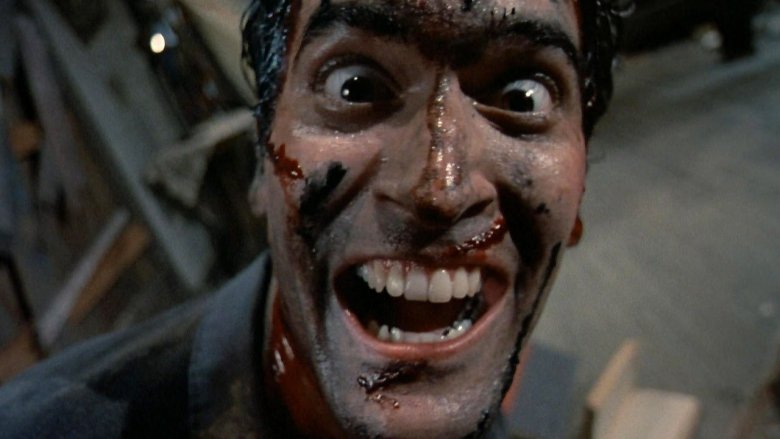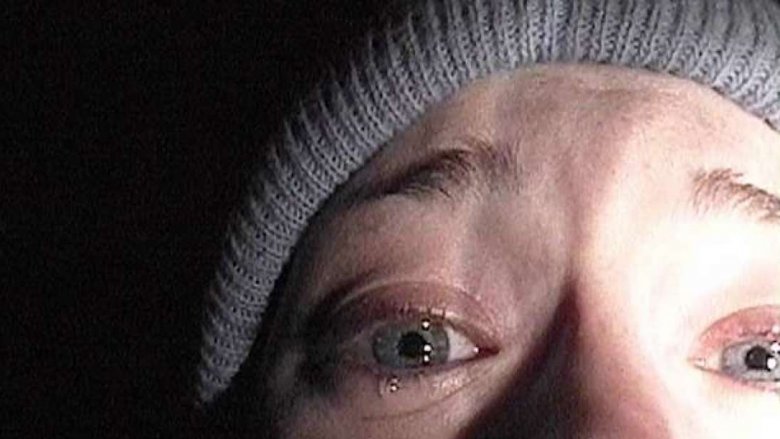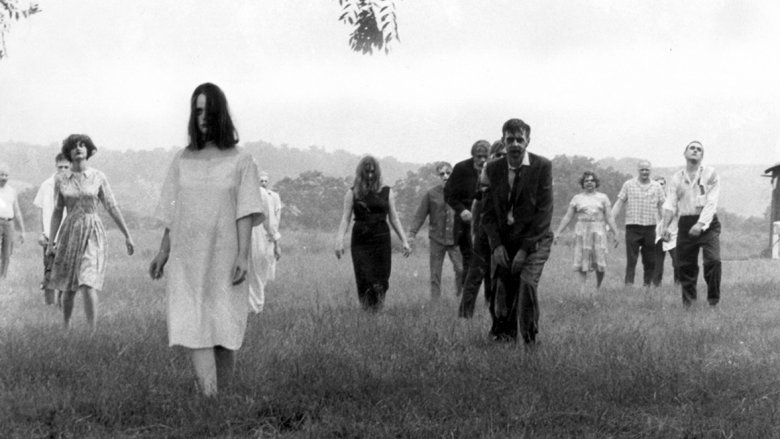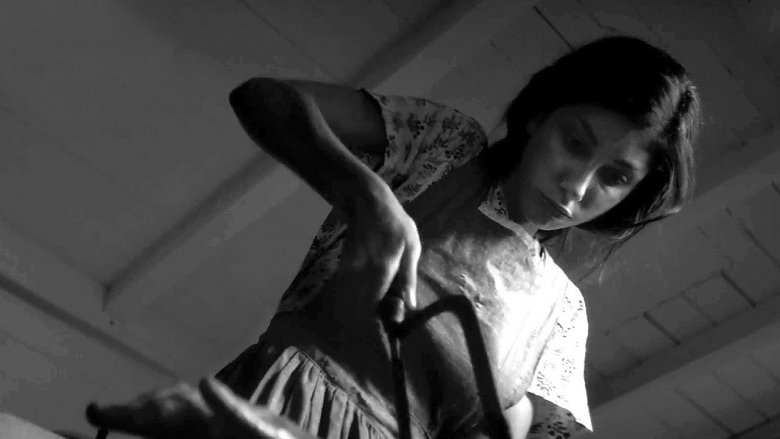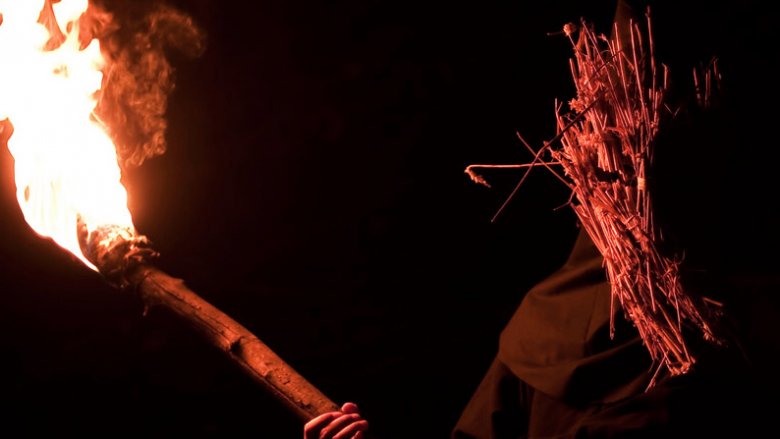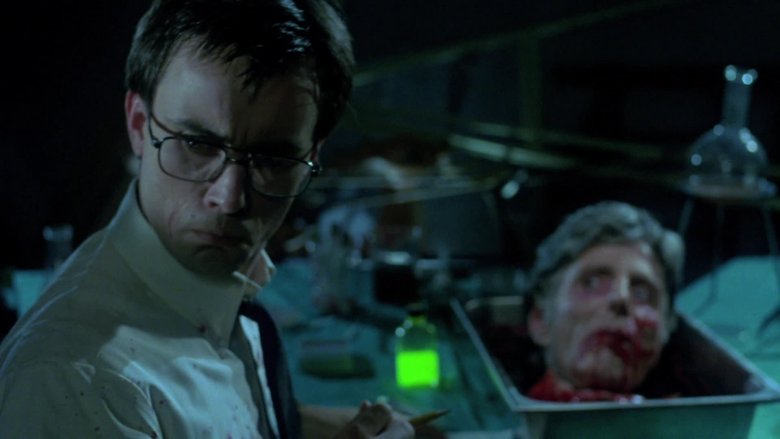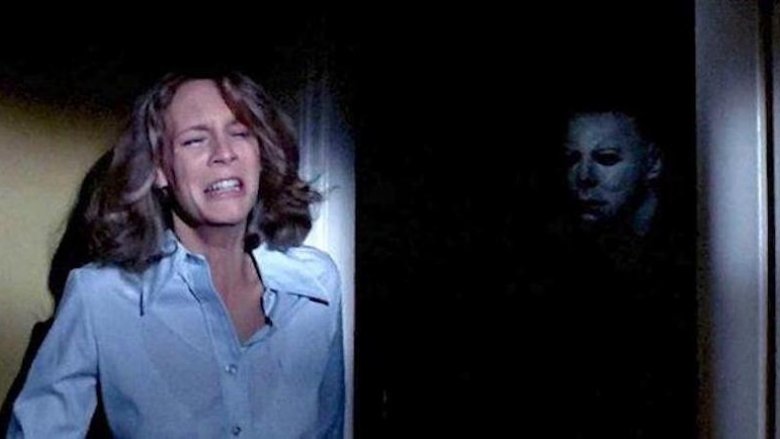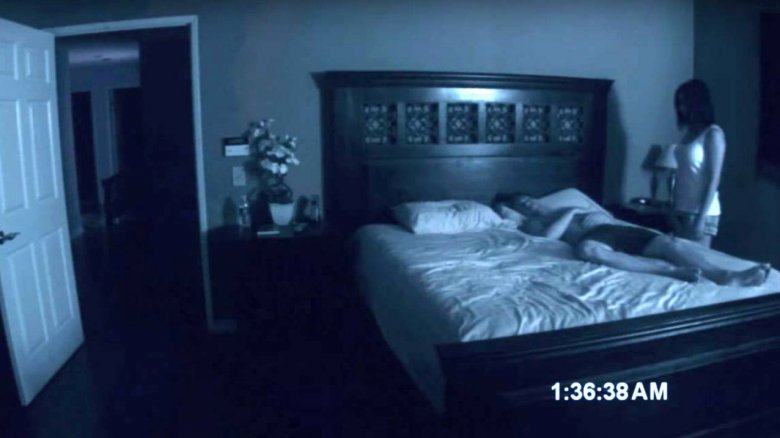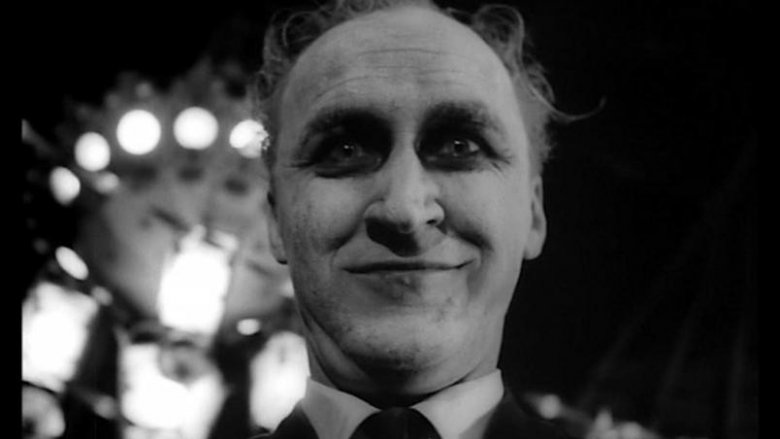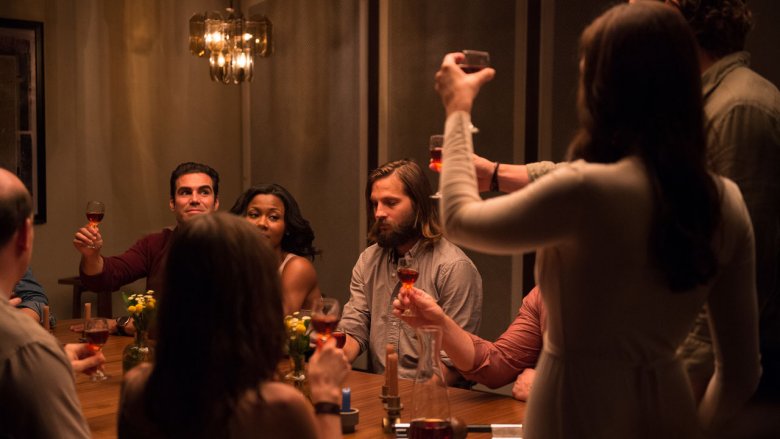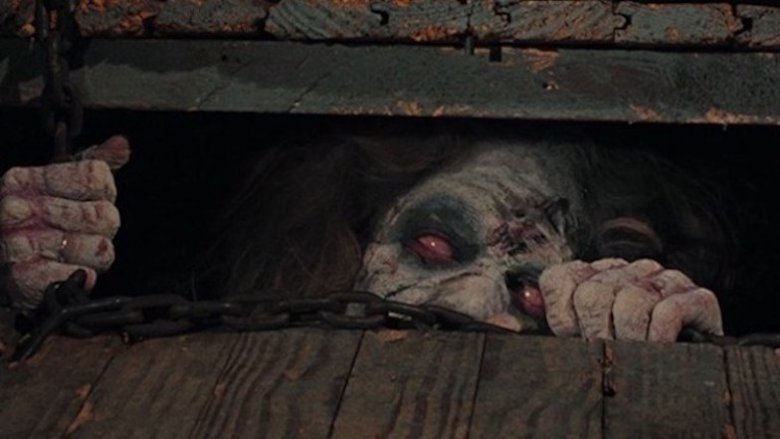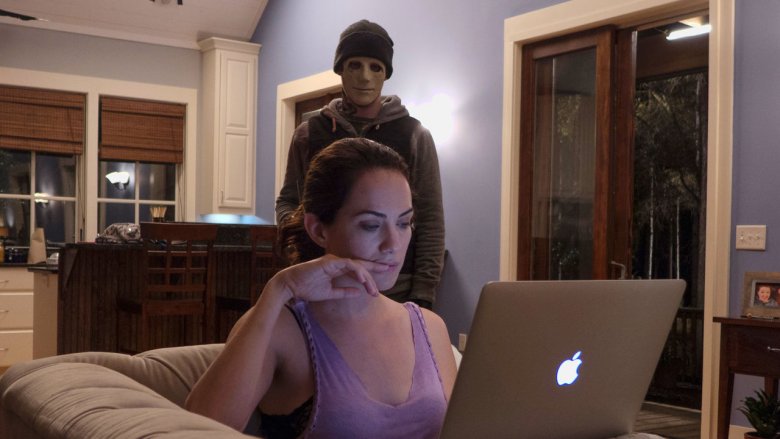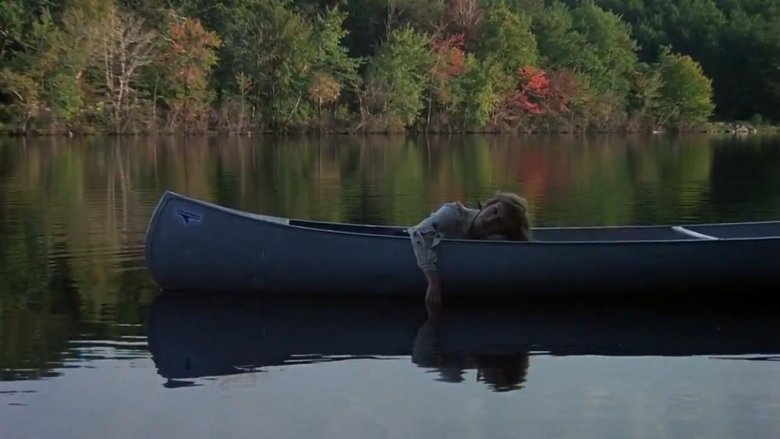Amazing Horror Movies Made On Shoestring Budgets
Whether we're talking about a heart-wrenching prestige drama, a schmaltzy rom-com, or an action-packed superhero bonanza, Hollywood has always managed to cash in with genre pictures. When it comes to cinema's biggest bang for the buck, however, studios big and small continue to mine the spooky, blood-spattered realm of horror.
And who can blame them? After all, horror movies cost less to produce, essentially require no big-name talent, and basically serve as the sweetest scare candy to the coveted 18-to-34 demographic. It's also worth noting that horror movies in all their bombastic, bloody bedlam (perhaps more than any other genre) both encourage and reward repeat viewings.
Just because a horror movies don't require MCU-sized financial backing doesn't mean they're cheap. Recent years have actually seen the genre not just raking it in at the box office, but also finding studios a little more willing to shell out for quality films with franchise potential. Still, most purists believe the genre on the whole is at its best when financial restrictions force innovation. Here's a look at a few amazing horror movies that truly innovated in spite of their shoestring budgets.
The Blair Witch Project - 1999
Few filmmakers have ever gotten more out of a meager budget than Eduardo Sánchez and Daniel Myrick. When the pair set out to turn their 35-page outline into a feature film in 1997, they'd cobbled together a mere $25,000 (though official budget numbers vary). That modest budget left the first-time filmmakers just enough loot to hire three completely unknown actors, drop them off in the woods with a couple of borrowed cameras, and hope that their efforts — coupled with the director's way outside the box concept — would be enough to turn that rough outline into a genuinely unsettling found-footage chiller.
It was more than enough. So real was the buzz behind The Blair Witch Project when it finally arrived in summer 1999, audiences flocked to theaters to see what many still believed to be legit found footage featuring the untimely demise of the three "students" involved. That has a lot to do with Sánchez and Myrick's radical/revolutionary marketing campaign, which never quite bothered to confirm or deny the movie's authenticity. That the film itself is such a viscerally unsettling experience in its own right only fanned the flames, and the combination turned Blair Witch into an unexpected box office behemoth to the tune of nearly $250 million in worldwide ticket sales, which also ranks it among the most profitable movies ever produced.
Night of the Living Dead - 1968
Throughout this list, you'll find a collection of films that found ways to defy expectations (or complete lack there of), and bring something truly unforgettable to the horror genre. What you won't find is another scary movie so singular in vision and execution that it basically invented a new subgenre for the horror realm. Make no mistake, that's exactly what George A. Romero's zombie classic Night of the Living Dead did when it hit theaters back in 1968, and moviegoers have been devouring tales of the flesh eating undead with unbridled glee ever since.
Of course, "game-changing horror" wasn't always the mantle Night of the Living Dead was meant to carry. Romero's feature debut originally set out to be a sci-fi comedy about hot-rodding aliens. When budget restraints made that concept all but impossible, the idea pivoted to flesh-eating aliens, and finally ended up on undead, flesh-eating humans, which allowed the production to make full use of its paltry $114,000 budget. To say Romero got his money's worth would obviously be an understatement. The film's gritty style, grisly special effects, and biting social commentary hit home with genre fans and neophytes alike, netting a staggering $18 million (approximately 250 times its budget) at the box office, and helped make Night of the Living Dead not just one of the most beloved indie films ever made, but one of the most important as well.
The Eyes of My Mother - 2016
There are horror movies that seek to shock you with gallons of fake blood and a relentless train of jump scares, and then there are horror films that show you unfathomable things you cannot unsee, hoping those things work their way under your skin to shake the very fiber of your being. Quite often, budget will dictate that sort of trajectory, as low budgets usually mean less fake blood and more psychological terror. If you want to know which side of the coin Nicholas Pesce's The Eyes of My Mother falls on, you should know that its budget came in around $250,000.
We're not implying that The Eyes of My Mother isn't gory. It is, and in ways that really need to be seen to be believed, so long as you understand the gruesome acts portrayed in Pesce's film are very much of the "cannot be unseen" variety. We should also note that, as grim as what Pesce does show us often is, the stuff he cleverly leaves to the imagination is infinitely worse. Horrific (yet stunningly photographed) imagery aside, the coup of The Eyes of My Mother is that the Pesce warps them into an intensely moody little story about deep-rooted emotional trauma and soul-crushing isolation. One that almost dares you to empathize with its troubled central character, even as she does unconscionable things. That balancing act makes Pesce's debut the sort of grounded, gut-wrenching low-budget horror that lingers in your brain long after the credits roll.
Kill List - 2011
As is the case with some of the better low-budget horror movies, a small plot twist to even the most well-trod narrative can prove the impetus for ghastly delights. Such is the case with Ben Wheatley's chilling 2011 breakthrough Kill List. If you haven't yet discovered this indie horror gem, it follows the tale of a disturbed war vet turned hitman who, almost a year after a badly botched assassination, leaves his wife and son for a seemingly simple hit in the English countryside. Once on the job, it becomes clear that this won't be quite as easy as advertised, and our hitman begins a rapid descent into a blinding madness he has little control over.
Along the way, Wheatley's seemingly run-of-the-mill drama dexterously twists into a tragically paranoid, Hammer horror-esque tale of psychological trauma with a nightmarish blend of gory, cult-centric devilry. The moments between are driven by a near suffocatingly ominous tone full of the sort of character-driven drama that made it easy for Wheatley to save the bulk of the film's modest $800,000 budget on effects for its shocking, heartbreaking, and deviously satisfying final 30 minutes. If you've yet to experience those final moments for yourself, we'd encourage you to stop reading this immediately and go watch Kill List immediately. We'll wait.
Re-Animator - 1985
Sometimes, even when a film turns out terribly, you can totally understand the hows and whys behind its existence. But some movies are so completely bonkers that, even if they turn out brilliantly, you simply cannot understand a producer ponying up even a five spot to get them made. Stuart Gordon's gory undead opus Re-Animator is one of the latter. Seriously, just try and imagine a pitch meeting that involved Gordon explaining to his would-be money men that at one point in his movie, a still living severed head would perform a sexual act on the female lead. Seriously, who greenlights that movie? And where do you find actors willing to play that scene?
Somehow, Gordon found willing participants across the board, and brought Re-Animator to the masses in 1985, blindsiding even the staunchest of genre fans with an astonishingly far out narrative fueled by even crazier gore and effects. In fairness to all involved, this masterpiece of the macabre does have an impressive progeny via the pen of horror maestro H.P. Lovecraft, but we'd have to wonder exactly what the famed scribe would make of Gordon's marvelously deranged adaptation. Whatever the case, we will be forever baffled by the fact that someone fronted Gordon and company close to a million bucks to make Re-Animator. We're also forever grateful that they did, 'cause Re-Animator remains completely bonkers in all the best ways.
Halloween - 1978
We're going to go ahead and assume that you know a thing or two about John Carpenter's near flawless 1978 slasher flick Halloween. It is, after all, one of the most venerated horror movies ever made, essentially birthing the slasher genre while paving the way for meticulously executed character-driven scares. As it happens, the film also sort of set the standard for finding stylish, wildly inventive ways to dispatch with that most cherished of horror tropes, lusty teens. Now, we're assuming all this because you're currently reading an article about no-budget horror films, and why would you be reading such an article otherwise?
Anyway, as much as you might claim to know about Carpenter's groundbreaking slasher, you may or may not realize that it more than earns its spot on this list, because the Horror Master himself had a mere $325,000 to bring his frightful vision to life. That slim budget is, of course, part of what helped Halloween stand out, forcing Carpenter to use innovative techniques — that killer steadicam/perspective of the killer opening, for instance — and making his seemingly inhuman monster a simple, jump-suited beast behind a now iconic mask. Though Carpenter and his many ghastly creations have continued to spook us over the years, few have ever unsettled us quite the way this micro-budget masterpiece did, and even fewer have genuinely stood the test of time with such monstrous eloquence.
Paranormal Activity - 2007
These days, we all know Jason Blum's Blumhouse Productions as the production powerhouse behind genre-centric hits like Sinister, Split, Get Out, Happy Death Day, and The Purge. Prior to 2007, the only people who'd heard of Blumhouse were Hollywood insiders who likely mocked the company's earnest ambition to produce high-quality/low-budget genre movies by giving complete creative control to the filmmakers. Largely improvised by non-professional actors, shot in seven days with a home video camera, and produced with a staggering $15,000 budget, Paranormal Activity didn't just fit the parameters for what Blumhouse was trying to do, it essentially became the blueprint.
Fittingly, Oren Peli's haunting tale of a young couple tormented by a malevolent demonic presence was the film that officially put Blumhouse on the Hollywood map. Once Blumhouse ran the film through the Paramount Pictures release pipeline and into wide distribution, Paranormal Activity scared up an astonishing $193 million at the box office. For the record, those numbers also earned the film the title of the most profitable movie ever made. With eyebrow-raising numbers like that, it wasn't long before people started throwing the "sequel" word around. Peli and Blumhouse's stark, no-budget vision birthed an entire franchise instead. To date, Blumhouse's Paranormal Activity-verse has spawned a total of five sequels that have brought in close to a billion dollars in worldwide ticket sales — not a bad return on an initial $15,000 investment.
Carnival of Souls - 1968
Of all the mocked, respected, even infamous names that have come and gone in the horror genre over the years, Herk Harvey is not often listed among them. There's a reason for that. The director spent the bulk of his life working on industrial/educational films for a small production company in Lawrence, Kansas. That's about as far from the Hollywood scene as one can get. As it happens, Harvey found inspiration for his one and only feature film when he spotted an abandoned carnival pavilion while shooting an industrial spot in California. On return to Kansas, he pitched the idea of a haunted carnival to a writer friend, and the rest, as they say, is history.
Well, not exactly "history." After negotiating a three-week vacation from his day job to shoot the film, and cobbling together a production budget of about $33,000, Harvey and company set out to bring the nightmarish vision that is Carnival of Souls to life. And that's just what they did, delivering a pitch-black, atmospheric psychological nightmare — complete with a patently game-changing twist ending — that was unlike any horror film that came before. Sadly, Carnival of Souls was all but ignored upon release in 1962, and it was one film and done for Harvey. In the ensuing years, Harvey's lone feature has gained legit cult cred as a horror film light years ahead of its time, but it still feels like not enough people have seen it.
The Invitation - 2016
After breaking onto the indie film scene with 2000's marvelous boxing drama Girlfight, the sky truly seemed the limit for director Karyn Kusama. Unfortunately, the lauded young filmmaker followed her low-budget breakthrough with the big-budget disaster that was Æon Flux. Kusama's post-Flux years found a career in flux as well. The middling box office of Kusama's Flux followup — the criminally overlooked, Diablo Cody-scripted horror romp Jennifer's Body — didn't exactly get things back on track. In the aftermath of those misfires, Kusama took a few years off before hitting the reset button on her career.
That reset came via the tense, paranoid horror thriller The Invitation, which the director delivered with a modest price tag of just $1 million. If you're unfamiliar with The Invitation, it follows a man who, after accepting an invitation to a dinner party hosted by his ex-wife and her new husband, begins to suspect the couple have ulterior motives for the get-together. Prior to the seemingly doomed dinner affair going deliciously off the rails, Kusama takes the slow-burn approach, building a near unbearable sense of dread that imbues The Invitation with a masterfully devilish/heartbreaking touch of realism. Kusama's dread-fueled drama instantly became one of the better-received horror films of recent years, and helped get Kusama out of the director's prison where she'd been unfairly confined.
The Evil Dead - 1981
Though he's dabbled almost exclusively in the realm of tentpole pictures (for better or worse) for the past couple of decades, Sam Raimi spent the early days of his career as a low-budget genre wiz with a dizzying penchant for delivering big laughs and bloody disembowelings with equal fervor. Case in point: Raimi's second feature film, 1981's gory ghoul-fest The Evil Dead. Though the effects-heavy film — which Raimi put together with a reported $350,000 — didn't exactly set the domestic box office ablaze, The Evil Dead more than turned a tidy profit for its investors upon release, and helped set a new standard for the growing wave of shock and schlock horror devotees.
More than anything, The Evil Dead delivered a genuinely disturbing, altogether unforgettable cinematic experience for anyone who's bought the ticket and went along for Raimi's blood-spattered ride over the years. It also proved Raimi a filmmaker of singular cinematic vision, and remains ground zero for the wild stylistic flourishes, unapologetic camp, and relentless bloodletting that would inform virtually every Raimi film that came after. That includes The Evil Dead's two sequels (Evil Dead II and Army of Darkness) and a surprisingly solid 2013 remake, not to mention the brilliant but short-lived TV spinoff Ash vs Evil Dead. Did we mention that the original Evil Dead also made a bona fide cult sensation of its chisel-chinned star Bruce Campbell?
Hush - 2016
Mike Flanagan has become not just one of the most prolific horror directors around, but also one of the most respected. That reputation stems from Flanagan's uncanny ability to put a wildly original, often deeply personal spin on even the most well-trodden of horror setups — i.e. a haunted artifact in Oculus, grieving parents and a "special" child in Before I Wake, or a haunted house/family in Netflix's marvelous The Haunting of Hill House. That he does so with relatively modest budgets is just icing on the cake.
Flanagan put a particularly clever spin on the home invasion thriller when he pitted a deaf writer against a masked killer bent on tormenting his would be victim before dispatching her. The elegantly titled Hush arrived on Netflix in 2016 after a solid SXSW premiere, and if you've already streamed this pitch-perfect nail-biter, you know the action doesn't exactly unfold according to the killer's plans. You also know Flanagan has a lot of fun twisting tired genre tropes into something wholly original, and delivering a "final girl" for the ages (played by Hush co-writer Katie Seigel) in the process. What's most surprising about Hush is that Flanagan — who reportedly made the film for a cool $1 million — accomplishes so much with a simplistic setup, two principal actors, and a single location. So however you feel about Flanagan's work, he continues to prove that making a movie on the cheap doesn't have to mean making a cheap movie.
Friday The 13th - 1980
Of course, a little cheap can go a long way in the horror game. If you want proof of that, look at Sean S. Cunningham's no-budget slasher marvel, Friday The 13th. On paper, Friday The 13th's tale of a masked killer offing horny teens in increasingly gruesome fashion is the sort of cheap that's led many to write the horror genre off as all shock and no art. To be fair, Friday The 13th didn't exactly bring the art back to the genre, but what Cunningham's film might have lacked in that department, it more than made up in mirthful, blood-spurting madness.
By now, most horror fans have watched, and re-watched, and re-re-watched Friday The 13th to the point that each shocking act of bloodletting can be timed down to the millisecond. What continues to fascinate about Cunningham's slasher-trash masterpiece is that it remains just as much fun to watch on 1,000th view as it is on the first. That may have to do with the killer's clever/tragic backstory, or with the obvious pleasure the filmmakers derived in finding inventive ways to kill off their cast, or perhaps it's because the pitch-perfect final scare is the stuff of genre legend. Whatever the case, it's worth noting that even in its cheapness, Friday The 13th somehow never rings false. That brevity is a big reason the film was such a hit upon release, and why it's still so surprising that Cunningham made the madness happen for just $550,000.
